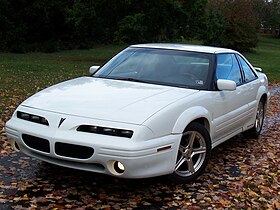GM W platform
The W-body was an automobile platform from General Motors which underpinned mid-size cars with front-wheel drive. The platform, originally code named GM10, began in 1982 under Chairman Roger B. Smith and debuted in 1988 with the Pontiac Grand Prix, the Buick Regal, and the Oldsmobile Cutlass Supreme coupés. Sedans followed for 1990. The engineering work was done by Chevrolet-Pontiac-Canada (CPC) group; also known as the small car division.
The platform cost $7 billion to develop and was to replace all midsize cars produced by Chevrolet, Pontiac, Oldsmobile, and Buick. The plan was huge in scope, calling for seven plants that would each assemble 250,000 of the cars, or 21% of the total U.S. car market. It was badly executed from the start, but GM’s 1984 reorganization, combined with changing market dynamics wrought havoc with the program and it never recovered. By 1989, the year before the last of the original GM10's were launched, GM was losing $2000 on every one of the cars it produced.
The later revision of this platform was known as the MS2000 or simply the W2-Car. Early versions used a transversely installed, fiberglass mono-leaf spring combined with struts in the rear. The "generation 1.5" W-body models had updated rear suspensions that used coil springs instead of the transverse leaf spring design inspired by the Chevrolet Corvette. For the 1997 model year the second generation W-body was released with a MacPherson strut coil spring design.
The W platform was updated in 2004 rather than being replaced by a stretched Epsilon platform, as had been planned. Metal fabrication of the floor pan for W-body cars were performed at the Parma Metal Center in Parma, Ohio. The cars were built at GM's Oshawa Car Assembly. The transverse use of GM's small-block engine in the W-bodies was a major addition for 2005.
...
Wikipedia

